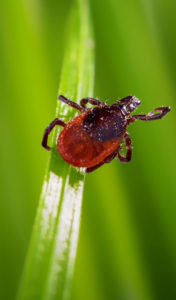An article from WWA’s Doctor’s Orders
This article originally appeared in Wisconsin Waterfowl Association’s July, 2019 eNewsletter.
 By K.C. Brooks, an avid waterfowler, dog lover and practicing veterinarian at Lodi Veterinary Care.
By K.C. Brooks, an avid waterfowler, dog lover and practicing veterinarian at Lodi Veterinary Care.
Keeping your hunting dog healthy and injury free is of major importance. After all, we usually have a sizeable investment in our hunting companion by the time they are ready to join us in the duck blind. Purchasing a quality pup (or started gun dog), feeding, training and veterinary care add up to a significant investment of time and money. One of the most significant threats to your dog’s health in Wisconsin (and the upper Midwest) is the variety of diseases carried by the ever increasing population of ticks in our area.
If you are of my vintage, you probably spent a great portion of your life free from having to deal with ticks. The ticks that were present in Wisconsin were found in low numbers and played little role in the transmission of disease to humans or canines.
Unfortunately, for a variety of reasons, multiple species of ticks now inhabit Wisconsin and are implicated in the transmission of serious illnesses for both dogs and their owners. In fact, new species of ticks (The Asian Longhorned tick) are now being discovered in the United States. New infectious agents (Borrelia mayonii) are being found in the existing ticks. In Wisconsin, the tick of most importance is Ixodes scapularis (The Deer Tick). The two most common diseases the deer tick transmits are Anaplasma and Lyme.
 Understanding tick biology and behavior is step one in developing a program to protect you and your dog from tick-borne disease. First, ticks are extremely prevalent in Wisconsin, so don’t expect that your dog is not going to be exposed. Second, most tick species (especially in their pre-adult stages) are tiny. Don’t expect that your visual inspection is likely to detect exposure. Most ticks are discovered by their owners after they are engorged with blood which may have left your dog already exposed to disease. Third, contrary to popular myth, ticks are not tree dwellers. Ticks prefer grassy fringes to mature trees. They actually “perch” on blades of grass and wait patiently for vibration, changes in temperature or carbon dioxide. This behavior is called questing, and it results in them eventually attaching themselves to a warm-blooded host. Interestingly, ticks appear to have individual preferences. Therefore, two dogs in the same environment may consistently have different exposures. Importantly, ticks are not killed by cold weather but have the ability to remain alive during even the most extreme Wisconsin winter conditions. Once the weather warms to around 35 degrees for a few days, ticks are able to resume their evil activity and often do so with vengeance.
Understanding tick biology and behavior is step one in developing a program to protect you and your dog from tick-borne disease. First, ticks are extremely prevalent in Wisconsin, so don’t expect that your dog is not going to be exposed. Second, most tick species (especially in their pre-adult stages) are tiny. Don’t expect that your visual inspection is likely to detect exposure. Most ticks are discovered by their owners after they are engorged with blood which may have left your dog already exposed to disease. Third, contrary to popular myth, ticks are not tree dwellers. Ticks prefer grassy fringes to mature trees. They actually “perch” on blades of grass and wait patiently for vibration, changes in temperature or carbon dioxide. This behavior is called questing, and it results in them eventually attaching themselves to a warm-blooded host. Interestingly, ticks appear to have individual preferences. Therefore, two dogs in the same environment may consistently have different exposures. Importantly, ticks are not killed by cold weather but have the ability to remain alive during even the most extreme Wisconsin winter conditions. Once the weather warms to around 35 degrees for a few days, ticks are able to resume their evil activity and often do so with vengeance.
The most important measure to protect your dog from tick-borne disease is the prevention of tick bites through the use of a Flea/Tick preventative. The ideal tick preventative is safe, highly effective and kills ticks quickly. This is important because high tick concentrations are common and most tick-borne disease can be transmitted within 24-72 hours of tick attachment. The available products come in three categories: 1) Topicals, 2) Collars, and 3) Oral (systemics). Your veterinarian can help you choose the product best for your situation. My personal preference for hunting dogs is a once a month oral product with excellent efficacy for all the important tick species in Wisconsin. Some topicals, and a rare collar, can approach the efficacy of the oral products. Unfortunately, the efficacy of topicals and collars is diminished late in the month due to the effects of swimming, bathing and sunshine. For the past several years, I have recommended the use of these products year-round due to regular periods of extreme warm weather often present in December, January and February. Remember, two or three days of temperatures above 35 degrees will often bring intense tick feeding activity.
Your dog can be further protected from Lyme disease through the use of an effective vaccine. Once again, a discussion with your veterinarian should be the basis for the use of the vaccine. Finally, I recommend yearly testing for tick-borne disease to determine the status of your dog. Dogs testing positive for tick-borne disease should have further blood tests to determine whether the organism is actually threatening the health of your companion.
Tick season is in full swing. Act now to protect your dog and avoid potentially life-threatening complications from tick-borne diseases. Enjoy your dog!


